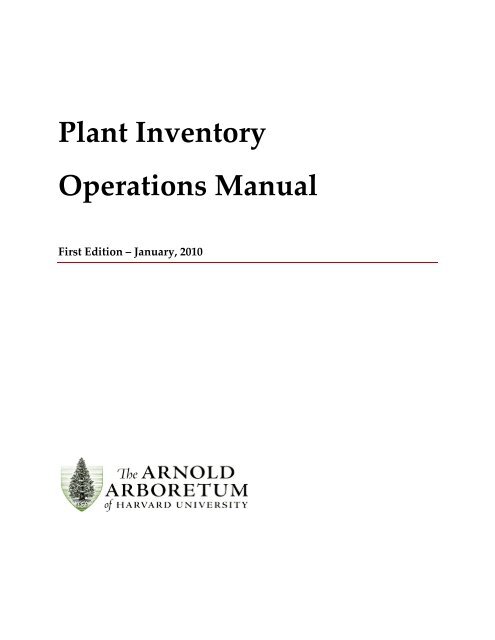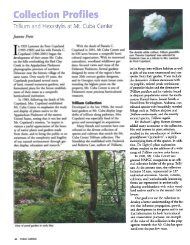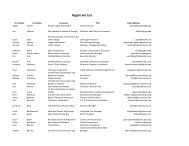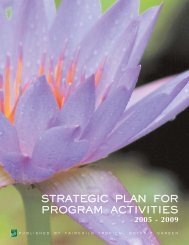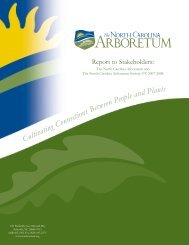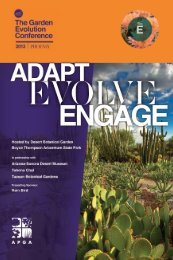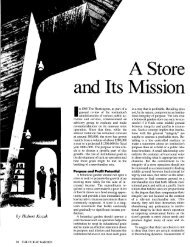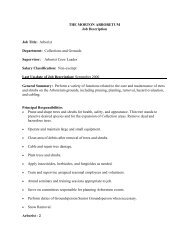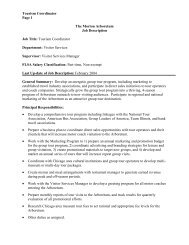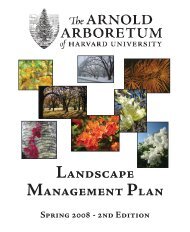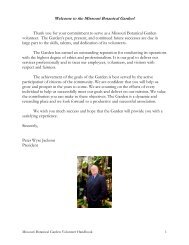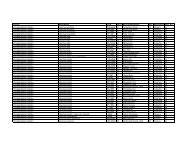Field Check Operations Manual, 2009 - American Public Gardens ...
Field Check Operations Manual, 2009 - American Public Gardens ...
Field Check Operations Manual, 2009 - American Public Gardens ...
You also want an ePaper? Increase the reach of your titles
YUMPU automatically turns print PDFs into web optimized ePapers that Google loves.
Plant Inventory<br />
<strong>Operations</strong> <strong>Manual</strong><br />
First Edition – January, 2010
Compiled by the Curation Department<br />
Michael Dosmann – Curator of Living Collections<br />
Abby Hird – Putnam Fellow, 2008 - 2010<br />
Sue Pfeiffer – Curatorial Fellow, 2008 - <strong>2009</strong><br />
Kyle Port – Plant Records Manager / Curatorial Associate<br />
Kathryn Richardson – Curatorial Assistant<br />
Copyright © 2010. The President and Fellows of Harvard College<br />
i
Contents<br />
1. INTRODUCTION<br />
1.1. Overview 1<br />
2. INVENTORY FIELD CHECK PROCESS<br />
2.1. Timeline 4<br />
2.2. Workflow 5<br />
2.2.1. Step 1 - Notify Horticulturist 6<br />
2.2.2. Step 2 - Gather Essential Materials and Tools 6<br />
2.2.3. Step 3 - Preview and Quick Audit Plant Records and Maps 8<br />
2.2.4. Step 4 - Conduct <strong>Field</strong>work 8<br />
2.2.5. Step 5 - Complete Office Tasks 14<br />
2.2.6. Step 6 - Accomplish Follow-up <strong>Field</strong> and Office Tasks 16<br />
2.2.7. Step 7 - Summarize Work with Horticulturists and Horticulture Managers 17<br />
2.2.8. Step 8 - Archive Work and Proceed to the Next Zone, Region, or Map 17<br />
3. CONSIDERATIONS<br />
3.1. Safety and Assistance 18<br />
4. RESOURCES<br />
4.1. Recommended Reading 19<br />
4.2. Tutorials, Guides and <strong>Manual</strong>s 19<br />
5. APPENDICES<br />
A. Inventory <strong>Field</strong> <strong>Check</strong> Timeline and Regions of Curatorial Focus 22<br />
B. Natural Disaster Response and Assessment 23<br />
C. Staff Managing Landscape Zones 24<br />
D. Landscape Management Zones 25<br />
E. Staff Nextel Telephone and Direct Connect Numbers 26<br />
F. Label Source Guide and Standards 27<br />
G. Plant Care Request Form, Plant Health Monitoring Card, and Workflow 31<br />
H. How to Enter and Process Label Requests Saved in BG-BASE v6.8 32<br />
I. BG-BASE PLANTS Table, <strong>Field</strong> <strong>Check</strong>s and Observations Section: <strong>Field</strong> Options 36<br />
J. Arnold Arboretum Medical Emergency Procedure 38<br />
ii
1. INTRODUCTION<br />
1.1. Overview<br />
Inventory 1 :<br />
Definition 1: (n) an itemized list of current assets<br />
Definition 2: (v) the act or process of taking an inventory<br />
Museums conserve objects, be they vases, bones, herbarium specimens or plants. Here at the<br />
Arnold Arboretum, preservation or conservation of our objects (in this case plants) includes<br />
expert horticultural care as well as strict curatorial oversight. Among curatorial activities in a<br />
museum, one of the most fundamental is the creation of an inventory of the accessioned objects<br />
housed within the collection. In basic form, an inventory lists what is being held within the<br />
collection and where the object is located. In combination, these two elements help to ensure<br />
collection accessibility to museum staff as well as other users. As a process, an inventorying<br />
system is also central to the conservation of the collection, as it introduces an evaluation or<br />
assessment step. In static collections, once an inventory is complete it only needs updating as<br />
new objects are registered or accessioned; current accessions are transferred to another location<br />
within the museum (e.g., a new storage area, an exhibit) or loaned to another institution; or<br />
accessions no longer needed are deaccessioned completely. However, botanic garden<br />
collections are dynamic, comprising living plants that are subject to innumerable vagaries.<br />
Plants constantly change: their condition may vary rapidly over a short period; they may shift<br />
from their original locations; and sometimes they disappear completely due to poor<br />
performance or even vandalism. And, unlike the uniform cabinets and cases that store<br />
traditional specimens, outdoor landscapes are highly variable. Like the plants they<br />
accommodate, landscapes change over time, and are subject to an array of abiotic and biotic<br />
influences. Lastly, some of the tools we use to track accessioned plants in the field, such as<br />
records labels, are themselves subject to these same influences. For these reasons, a system for<br />
inventorying living plant collections is quite different from that used in a static collection and<br />
must address some of these unique curatorial challenges.<br />
1<br />
Definition: Inventory. (<strong>2009</strong>). In Merriam-Webster Online Dictionary. Retrieved March 29, <strong>2009</strong>, from<br />
http://www.merriam-webster.com/dictionary/inventory<br />
1
Conducted ‚in the field,‛ these activities are known as field checks and are perhaps the singlemost<br />
important process whereby curatorial staff and others interface with the living collection.<br />
As a means of organization, field checks can be segregated into two primary categories. Those<br />
that are part of a routine and systematic review are classified as inventory field checks. These<br />
formal procedures are conducted by curatorial staff and are most often associated with a<br />
discrete geographic location such as a map grid or nursery, although in cases such as the Center<br />
for Plant Conservation (CPC) collections might be distributed across the landscape. The other<br />
class, ad hoc field checks, includes all other activities that result in observations or notations<br />
made on accessioned plants at a documented point in time. Examples include the collection of<br />
voucher specimens, horticultural maintenance activities, plant-health inspections, and even<br />
casual observations made by staff or visiting scholars. While they may not be systematic in<br />
nature, collectively these represent a rich body of secondary documentation. One need only to<br />
peruse the card file or back issues of Arnoldia to find amazing commentary on our accessioned<br />
plants. A goal of this manual is to ensure the integration of these notes and observations into<br />
the documentation process.<br />
The value of inventory field checks cannot be overstated. Because curatorial and horticultural<br />
staff rely heavily upon inventories and maps of the living collections in their daily work, failure<br />
to maintain these to their fullest can result in an incomplete and inaccurate inventory, which in<br />
turn jeopardizes the future preservation of the accession in question. Thus, at its most basic<br />
level, a field check system requires:<br />
‣ all accessioned plants to be routinely verified as being present or absent;<br />
‣ the specific map locations of accessioned plants to be verified for accuracy and precision;<br />
‣ the identities of accessioned plants to be coarsely verified for accuracy; and<br />
‣ the primary means of collections control in the field (records labels) to be assessed for<br />
accessibility, accuracy, and presentation.<br />
To meet these objectives, the Arboretum fields expert curatorial staff able to conduct inventories<br />
as well as troubleshoot an array of taxonomic, cartographic, and horticultural puzzles.<br />
This <strong>Manual</strong> serves several purposes. The initial and basic intention is as a means of<br />
documentation: to put into print for the first time the Arboretum’s meticulous procedures<br />
related to inventorying living plants. Thus, it becomes a resource for staff to use as they carry<br />
out their day-to-day work. Also, because it is a document unique in the public garden<br />
community, it also can be used as a resource by peer institutions. The creation of the document<br />
also proved meaningful. During the process of writing and editing, curatorial and other staff<br />
2
members had the opportunity to scrupulously assess our current practices in light of a bolder<br />
and more expansive curatorial paradigm. As a result, current practices were evaluated to see if<br />
they met curatorial needs and requirements; any necessary changes for improvement were then<br />
crafted. The end product, this <strong>Manual</strong>, is a composite of tried-and-true methods and many new<br />
approaches.<br />
The following table details improved inventory methods and new approaches.<br />
Table 1. Improved Inventory Methods.<br />
TOPIC PREVIOUS METHOD NEW METHOD<br />
Communication of inventory<br />
value, goals, and procedures<br />
Communication with<br />
horticulturists and Horticulture<br />
Dept. managers<br />
Data collection<br />
In field and office trainings with<br />
scant documentation<br />
As needed; if at all<br />
<strong>Field</strong> observations written on<br />
paper then catalogued in data<br />
management systems<br />
In field and office trainings<br />
supplemented by Plant Inventory<br />
<strong>Operations</strong> <strong>Manual</strong> (2010)<br />
Formalized and required<br />
<strong>Field</strong> observations catalogued in<br />
real time using a laptop computer<br />
with 3G card<br />
Plants field checked in grid A majority of accessioned plants All accessioned and existing<br />
plants; excludes woodland areas<br />
Coarse identification of plant Inconsistently reviewed<br />
Required and expected<br />
material (verification)<br />
Measurement<br />
diameter at breast height<br />
(DBH)<br />
Largest stem<br />
All stems; unless otherwise noted<br />
Plant condition definitions<br />
Plants listed as<br />
‚unable to locate‛<br />
January, 2003 standard definitions<br />
used<br />
Inconsistently reviewed<br />
Definitions revised March, <strong>2009</strong><br />
Required review and notation<br />
standardized<br />
3
2. INVENTORY FIELD CHECK PROCESS<br />
2.1. Timeline<br />
Planned inventory field checks are conducted across the Arboretum landscape on a four year<br />
cycle (see Appendix A, Inventory <strong>Field</strong> <strong>Check</strong> Timeline and Regions of Curatorial Focus).<br />
Inventory field check operations are suspended at various times throughout the growing season<br />
to allow for conservation inventories, (e.g., Center for Plant Conservation [CPC]), seasonal<br />
mapping of new plantings, label need sweeps in advance of special events, research use, visitor<br />
use, (e.g., self-guided tours, interpretive installations), records review (data clean-up), map<br />
book publication, and/or natural disaster response (see Appendix B, Natural Disaster Response<br />
and Assessment).<br />
Examples of annual curatorial tasks that fall outside the scope of formal inventory activities<br />
include:<br />
April<br />
•GPS spring plantings<br />
May<br />
•Assess label need in the lilac collection prior to Lilac Sunday.<br />
July<br />
•<strong>Field</strong> check CPC holdings<br />
September<br />
•Assess label need in Leventritt Garden (LG) and Dana Greenhouse (DGB) locations<br />
prior to the Plant Giveaway.<br />
October<br />
•GPS fall plantings<br />
February<br />
•Map Book production<br />
4
2.2. Workflow<br />
The process below emphasizes the broad categories of action constituting the Arboretum’s<br />
inventory field check program. Each action is further outlined in subsequent pages.<br />
Circumstance and/or individual preference may, at times, require field check activities to<br />
deviate from this recommended workflow. However, history and staff experience bear witness<br />
to the workflow’s effectiveness in fostering required outcomes. Outcomes include:<br />
authenticated, accessible, well-documented collections that foster research, education, and<br />
general use; knowledgeable, well-trained staff who perform in a meritorious manner in their<br />
day-to-day work.<br />
ARNOLD ARBORETUM INVENTORY FIELD CHECK WORKFLOW<br />
Step 1<br />
Notify horticulturist(s)<br />
Step 6<br />
Accomplish follow-up<br />
field-work and office<br />
tasks<br />
Step 7<br />
Summarize work w/<br />
horticulturist and<br />
horticulture managers<br />
Step 2<br />
Gather essential<br />
materials and tools<br />
Step 5<br />
Complete office tasks<br />
Step 8<br />
(As needed)<br />
Compile reports and<br />
distribute maps<br />
Step 3<br />
Preview and quick audit<br />
plant records and maps<br />
Step 4<br />
Conduct field-work<br />
Step 9<br />
Archive fieldwork maps<br />
and inventories;<br />
Proceed to the next<br />
zone, region, or map<br />
The Manager of Plant Records, in consultation with the Curator of Living Collections, manages<br />
inventory activities in the permanent collections. Other curatorial staff are critical contributors in the<br />
inventory process and are necessary members of the field check team.<br />
5
2.2.1. Step 1 - Notify Horticulturist<br />
The week before fieldwork commences, it is required to notify the horticulturist, gardener, or<br />
apprentice managing the zone (map area) of upcoming field check activities. This allows staff<br />
to bring certain questions or concerns to the attention of curatorial staff and enriches the field<br />
check process by encouraging discussion about the living collections.<br />
Refer to Appendix C for a list of staff managing landscape zones (landscape zones can be found<br />
in Appendix D).<br />
Communication before, during, and after field work ensures completeness of field checks and<br />
enhances communication and awareness.<br />
See Appendix E, Staff Nextel Telephone and Direct Connect Numbers.<br />
2.2.2. Step 2 - Gather Essential Materials and Tools<br />
The following materials and tools are used at various stages in the inventory field check process<br />
and can be retrieved from curatorial offices located in the Hunnewell building, fourth floor<br />
studio:<br />
‣ Laptop computer – Remote desktop and broadband access technologies allow BG-BASE<br />
users an opportunity to review and edit records in the field.<br />
‣ Living and dead plant inventory – A location-based stock-taking list(s) generated<br />
directly from BG-BASE using the Query>Inventory menu option.<br />
‣ Living Collections Map Book – An annual publication detailing georeferenced features<br />
such as plants, hardscape, and wayfinding aids.<br />
‣ “Dead” plant map – A map depicting the locations of dead, unlocated, and removed<br />
plants.<br />
‣ Form and card<br />
• Plant Care Request Form, green pad or booklet<br />
• Plant Health Monitoring Card, yellow pad or booklet<br />
‣ Measurement devices<br />
• Leica DISTO Laser Distancemeter – measures distance, height, and GPS offsets<br />
• Diameter tape – measures diameter at breast height in centimeters.<br />
• Haglöf Electronic Clinometer – Provides accurate height and angle<br />
measurements. Accuracy ± 1’ (0.3 m); ± 1 degree (depending on the accuracy of<br />
the distance entered).<br />
‣ Nextel mobile phone – Direct Connect (walkie talkie) feature facilitates communication<br />
with collections managers, horticulturists, and Visitor Services staff.<br />
‣ Plastic labels, yellow – Temporary labels used to identify plants in need of records<br />
labels.<br />
6
‣ Pruners<br />
‣ Reference books – General or specific references that can be used in the field.<br />
Suggestions include:<br />
• Rehder, A. Bibliography of Cultivated Trees and Shrubs Hardy in the Cooler Temperate<br />
Regions of the Northern Hemisphere. Jamaica Plain, MA: Arnold Arboretum. 1949.<br />
825 pp.<br />
• Dirr, M. <strong>Manual</strong> of Woody Landscape Plants: Their Identification, Ornamental<br />
Characteristics, Culture, Propagation and Uses. Champaign, Ill. : Stipes Pub., <strong>2009</strong>.<br />
The Dana Greenhouse facility maintains a small library that can be accessed during<br />
office hours.<br />
‣ Tool belt(s) and/or backpack(s)<br />
‣ Trimble ProXRT GPS (Global Positioning System) receiver – Records the coordinates<br />
of features (plants, benches, signage, millstone, etc.) with decimeter accuracy. Aids in<br />
navigating to previously georeferenced features.<br />
The Trimble ProXRT receiver with Trimble Nomad handheld should be used to<br />
GPS all plant material.<br />
‣ Trunk and/or records label adjustment devices<br />
• Cordless drill; standard, Phillips, and square bits<br />
• Hammer, pry bar, needle nose pliers, stainless steel screws<br />
‣ Writing and highlighting instruments<br />
• Yellow and blue highlighters for marking maps<br />
• Permanent marker (Sharpie preferred) for writing on temporary plastic labels<br />
‣ First Aid Kit(s)<br />
• Portable first aid kit for fieldwork<br />
• In vehicle; Ford Freestyle<br />
7
2.2.3. Step 3 – Preview and Quick Audit Plant Records and Maps<br />
Efficiencies are gained by reviewing all grid/zonal materials before beginning the inventory<br />
field check process.<br />
‣ Compare plant inventories (dead and alive) to maps<br />
‣ Highlight plants that are not georeferenced<br />
‣ Review identifying characteristics of taxa to be field checked prior to going outside<br />
2.2.4. Step 4 – Conduct <strong>Field</strong>work<br />
<strong>Field</strong> work should be conducted by a two person team. The division of labor will depend on<br />
the team assembled; however, both team members should assist each other in evaluating plant<br />
condition and verifying plant identity. During data collection, one person typically enters<br />
observations and label need into BG-BASE while the second person verifies map features, fills<br />
out forms/cards, and scrutinizes labels. After all observations and clerical efforts are complete,<br />
proceed to the next plant.<br />
ARNOLD ARBORETUM INVENTORY FIELD CHECK WORKFLOW:<br />
CONDUCT FIELDWORK<br />
1) Navigate<br />
2) Vet<br />
3) Evaluate<br />
Plant<br />
4) Report<br />
5) Verify<br />
accessioned<br />
plants<br />
non-accessioned<br />
(existing) plants<br />
label text,<br />
placement and<br />
condition<br />
map features<br />
coarse identity<br />
condition<br />
(health)<br />
metric<br />
measurements<br />
reproductive<br />
/vegetative<br />
status<br />
Plant Care<br />
Request Form<br />
Plant Health<br />
Monitoring Card<br />
mark maps<br />
label need<br />
plant identity<br />
sex<br />
pest and disease<br />
1) Navigate – All plants within a map location must be field checked. This includes<br />
accessioned and non-accessioned (excludes woodlands) plant material. This step<br />
requires less reliance on maps and more emphasis on observing actual plant material.<br />
Symbols on a map may reflect the relative position of plant material. Labels can be hung in<br />
error. Observe plants first then consult inventory field check materials.<br />
8
2) Vet –<br />
a) Label text, placement and condition –<br />
• Read records and trunk label text thoroughly (see Figure 1, How to read a<br />
plant label).<br />
• Note placement of the label and the way in which label wire is twisted<br />
(see picture on pg. 27, Appendix F, Label Source Guide and Standards,<br />
indicating the preferred wire twisting method).<br />
• Remove redundant labels.<br />
• Make note of label need (see Table 2, pg. 10, Standardized Map and<br />
Inventory Notations used in <strong>Field</strong> <strong>Check</strong> <strong>Operations</strong> at the Arnold Arboretum;<br />
see also Appendix F, Label Source Guide and Standards).<br />
• Hang a yellow temporary label if both records labels are missing. Using a<br />
Sharpie marker, write the accession number, qualifier, and name<br />
(abbreviated) on the label.<br />
Figure 1.<br />
9
) Map features – Double-check for correct spatial relationships of map features<br />
(e.g., plants, signage, rocks, etc.).<br />
• Highlight features that are not georeferenced (see Table 2, Standardized<br />
Map and Inventory Notations used in <strong>Field</strong> <strong>Check</strong> <strong>Operations</strong> at the Arnold<br />
Arboretum).<br />
• Draw in features that are not reflected on the map.<br />
Table 2. Standardized Map and Inventory Notations used in <strong>Field</strong> <strong>Check</strong> <strong>Operations</strong> at the<br />
Arnold Arboretum.<br />
NOTATION OBJECT ACTION<br />
GPS (highlight<br />
yellow)<br />
feature(s) (e.g., plants, bench)<br />
georeference<br />
Accession plant accession<br />
ID plant verify (e.g., labels hung incorrectly,<br />
plant misidentified from original<br />
source)<br />
Labels<br />
L<br />
2L<br />
TM<br />
TMA<br />
TMR<br />
records label<br />
‚<br />
trunk label<br />
‚<br />
‚<br />
emboss (1)<br />
emboss (2)<br />
mount or order<br />
adjust<br />
remove<br />
OK feature(s) edit(s) complete; action taken<br />
Surgery (highlight<br />
blue)<br />
label, nail, screw, and/or wire<br />
engulfed by cambium<br />
adjust, remove, repair<br />
UNLOC plant or hardscape feature double-check<br />
/ or \ feature(s) verified (no action required)<br />
? feature(s) research, report, document<br />
3) Evaluate Plant – Using a laptop computer, input evaluative data in the appropriate BG-<br />
BASE PLANTS table fields or write on a hardcopy inventory (see pg. 6, Section 2.2.2. Step<br />
2 - Gather Essential Materials and Tools) if broadband connection is down or weather<br />
hinders use of electronic devices. Quickly examine previous notations made in the<br />
PLANTS table, as they often are illustrative and aid in evaluation. For instance, the<br />
plant may have recently been coppiced and the DBH entry may contradict in-field<br />
observations. Also, be a skeptic and on the lookout for plants that appear atypical –<br />
perhaps unlike other qualifiers of the same accession or some other deviation from the<br />
type. Such oddities could indicate unusual seedling variation, mismapped features, or<br />
perhaps misidentified or wrongly-hung labels.<br />
10
Do not enter a field check if the plant material is in any way questionable. Likewise, read<br />
prior field check thoroughly; they may indicate error(s). Additional sleuthing may be<br />
necessary (see pg. 14, Section 2.2.5. Step 5 – Complete Office Tasks, Consult).<br />
a) Coarse identity – Does the plant and label information match? If the label and plant<br />
do not match, additional verification may be necessary (see pg. 13, Verify Plant<br />
Identity).<br />
b) Condition – Assign a subjective health rating. The Arnold Arboretum has<br />
operationally defined BG-BASE plant conditions as follows:<br />
Making observations on living plants in the collection is an integral part of the<br />
documentation process. In order to facilitate objectivity and to ensure common usage<br />
among evaluators, the following standardized condition definitions are to be used as a<br />
guide for staff and others during their plant health assessments. Special projects and/or<br />
other collection management activities such as the Plant Health Program may dictate<br />
additional plant condition use.<br />
LIVING PLANT CONDITIONS:<br />
Alive (A) - Plant present.<br />
Primarily used in the dormant season or if none of the observations relate to<br />
plant health: e.g., presence/absence notations, phenology, only<br />
aesthetic/ornamental value, height/DBH measures, etc.<br />
Historic evaluations; e.g., date or year noted on accession cards, maps,<br />
correspondence, etc.<br />
<strong>Check</strong>_note field use encouraged<br />
Excellent (E) - An outstanding and/or exemplary plant, not just in good health<br />
but thriving (vigorous).<br />
No recent structural damage or defects; no pest(s) or disease(s)<br />
Past damage has fully compartmentalized<br />
<strong>Check</strong>_note field use required<br />
Good (G) - A plant in good health, actively growing, no evidence of decline.<br />
Minor structural damage or disease that is not significantly harming the plant<br />
(e.g., powdery mildew can still grow on a ‚good‛ Syringa).<br />
Compartmentalization proceeding well<br />
<strong>Check</strong>_note field use encouraged<br />
Fair (F) - A plant in minor decline (minimal vigor), but not life-threatening.<br />
Notable pathological, structural, or physical damage<br />
11
o Some form of stress or pressure is evident (or at least the symptoms<br />
are); may have some active growth or is in stasis.<br />
Compartmentalization not proceeding well<br />
May prompt the completion of a Plant Care Request Form (green) or Plant<br />
Health Monitoring Card (yellow)<br />
o Further monitoring may be necessary<br />
<strong>Check</strong>_note field use required<br />
Poor (P) - A plant in major decline, the problem is life-threatening, and the<br />
expectation is that the plant will be dead within 1 to 2 years unless remedial<br />
action is taken.<br />
Major pathological, structural, or physical damage<br />
No evidence of active growth<br />
No compartmentalization<br />
Warrants the completion of either a Plant Health Request Form (green) or Plant<br />
Health Monitoring Card (yellow card).<br />
<strong>Check</strong>_note field use required<br />
DEAD PLANT CONDITIONS:<br />
Dead (D) - A dead plant still in place.<br />
No living tissue.<br />
<strong>Check</strong>_note field use required<br />
Deaccessioned and/or Removed (R) - A plant removed from the collection because<br />
of death, curatorial review, or other permanent action.<br />
<strong>Check</strong>_note field use required<br />
Unable to locate (U) - An unfound plant. USE SPARINGLY (see pg. 16, Section 2.2.6<br />
Step 6 - Accomplish Follow-up <strong>Field</strong> and Office Tasks, Update).<br />
Requires follow-up to confirm ‚unlocated‛ status.<br />
Confirmed unlocated plants must have ‚confirmed unable to locate‛ noted in<br />
the check_note field.<br />
<strong>Check</strong>_note field use required<br />
c) Measurements –<br />
• Diameter at breast height (DBH) of all trees – The Arboretum generally<br />
follows the USDA Forestry Standard (see Recommended Reading section,<br />
USDA Forest Inventory and Analysis National Core <strong>Field</strong> Guide, v 4.0. 2007).<br />
Rules of thumb<br />
o<br />
Measure all stems at 4.5 feet above soil line and enter the<br />
information in BG-BASE, PLANTS table, field DBH. <strong>Field</strong><br />
DBH_MISC can be used to articulate height at which DBH<br />
is taken if the aforementioned standard is not followed.<br />
12
o Stand on the upslope side of the stem(s) being measured<br />
• Height and Spread – As needed and at the discretion of curatorial staff.<br />
Include notations of spread for shrub masses if they are particularly<br />
useful for future interpretation, mapping, etc.<br />
d) Reproductive Status – Primarily captured as flowering is encountered, but can<br />
be applied during fruiting or before flowering. Also can be useful when noting if<br />
something is atypically NOT in flower. Use free-text descriptions if and when<br />
appropriate (see Appendix I, BG-BASE PLANTS, <strong>Field</strong> <strong>Check</strong>s and Observations<br />
Section: <strong>Field</strong> Options).<br />
e) Vegetative Status – Observations catalogued when unusual leaf drop or leaf<br />
emergence is encountered as well as leaf color in autumn (see Appendix I, BG-<br />
BASE PLANTS, <strong>Field</strong> <strong>Check</strong>s and Observations Section: <strong>Field</strong> Options).<br />
f) Sex - Enter when sex of dioecious accessions has not been determined (see<br />
Appendix I, BG-BASE PLANTS, <strong>Field</strong> <strong>Check</strong>s and Observations Section: <strong>Field</strong><br />
Options).<br />
g) Pests and Disease – BE ON THE LOOKOUT FOR ANYTHING ABNORMAL. A<br />
Plant Health Monitoring Card should be filled out for pest and disease issues (see<br />
Appendix G, Plant Care Request Form, Plant Health Monitoring Card, and Workflow).<br />
4) Report –<br />
a) Fill out Plant Care Request Forms and Plant Health Monitoring Cards as needed. All<br />
forms and cards should be submitted to the Curator of Living Collections.<br />
b) Mark maps (see pg. 10, Table 2 Standardized Map and Inventory Notations used in<br />
<strong>Field</strong> <strong>Check</strong> <strong>Operations</strong> at the Arnold Arboretum).<br />
c) Request labels by entering a record in the LABEL_REQUESTS table (see<br />
Appendix H, How to Enter and Process Label Requests Saved in BG-BASE v6.8).<br />
Report all poison ivy and/or invasive woody plants to be removed using a<br />
Plant Care Request Form!<br />
5) Verify Plant Identity– A coarse identity verification should be made for each plant in<br />
the field, and for those particularly suspect a more detailed investigation can be<br />
conducted. This may require the collection of sexual and vegetative samples.<br />
• Double-check maps and labels.<br />
• Initiate in-field ID using reference materials (e.g., books, key, photo<br />
guides, etc.).<br />
• Collect plant samples for further investigation; use references, the<br />
herbarium, archival maps, etc. Coordinate efforts with the Curator of<br />
Living Collections or fill out a Plant Care Request Form as needed.<br />
13
2.2.5. Step 5 – Complete Office Tasks<br />
After fieldwork has been completed, divide office tasks following the schedule recommended<br />
below.<br />
ARNOLD ARBORETUM INVENTORY FIELD CHECK WORKFLOW:<br />
COMPLETE OFFICE TASKS<br />
1) Submit<br />
2) Enter Data<br />
3) Consult<br />
4) Edit or<br />
Append<br />
5) Notify<br />
6) Emboss<br />
7) Print or<br />
Plot<br />
Plant Care<br />
Request<br />
Form(s)<br />
Plant<br />
Health<br />
Monitoring<br />
Card(s)<br />
field<br />
observations<br />
(if not done<br />
in the field)<br />
archives<br />
herbarium<br />
library<br />
staff<br />
records<br />
maps<br />
researchers<br />
curatorial<br />
staff<br />
labels<br />
maps<br />
1) Submit – Plant Care Request Forms should be submitted to the Curator of Living<br />
Collections as soon as possible. Likewise, timely Plant Health Monitoring Card<br />
submission, to the Curator, will ensure appropriate actions are taken.<br />
2) Enter Data – If not done in the field<br />
a) Enter field observations in PLANTS table, BG-BASE<br />
b) Enter label needs in the LABEL_REQUESTS table, BG-BASE<br />
3) Consult – A broad suite of resources can fill in gaps in understanding or expedite<br />
problem solving. Resources include:<br />
a) Archival documentation (accession card file, verification records, map case, map<br />
books, AutoCAD drawings, previously entered BG-BASE records, etc.)<br />
b) Cultivated Herbarium - The Cultivated Herbarium contains approximately<br />
130,800 specimens of cultivated origin. Of these, over 48,000 specimens<br />
document accessions grown at the Arnold Arboretum throughout its history.<br />
http://www.arboretum.harvard.edu/plants/herbarium.html<br />
c) Horticultural Library - To support the research, curatorial, and educational<br />
programs of the Arboretum, the library collects works on botany, dendrology,<br />
horticulture, floras of the world, forestry, and taxonomy.<br />
http://www.arboretum.harvard.edu/library/about_lib.html<br />
d) Staff<br />
Challenge assumptions! Plants may be labeled and/or mapped incorrectly.<br />
14
4) Edit or Append – Edit or append database (BG-BASE) records and map features based<br />
on archival records review.<br />
a) The CHECK_NOTE field (free text) in PLANTS should be used to record any<br />
anomalies, questions, and findings (e.g., labels were hung incorrectly, mapped<br />
wrong, etc.). Notes in the CHECK_NOTE field are essential in problem solving<br />
in the future and limit the propagation of errors.<br />
Do not OVERWRITE OR DELETE information from data management systems<br />
(BG-BASE, ArcGIS) without consulting with or obtaining instruction from the<br />
Curator or Manager of Plant Records.<br />
5) Notify – If errors are found, researchers and/or curatorial staff managing associated<br />
collections and/or programs (e.g., herbarium, repropagations, distributions) must be<br />
notified.<br />
6) Emboss – Emboss records labels as needed (see Appendix H, How to Enter and Process<br />
Label Requests Saved in BG-BASE v6.8).<br />
7) Print or Plot – Edited maps will be used to accomplish follow-up field work (see pg. 16,<br />
Section 2.2.6. Step 6 - Accomplish Follow-up <strong>Field</strong> and Office Tasks).<br />
15
2.2.6. Step 6 – Accomplish Follow-up <strong>Field</strong> and Office Tasks<br />
Follow-up field work and office tasks may be necessary. See additional steps below.<br />
ARNOLD ARBORETUM INVENTORY FIELD CHECK WORKFLOW:<br />
ACCOMPLISH FOLLOW-UP FIELD AND OFFICE TASKS<br />
1) Label(s)<br />
2) GPS<br />
3) Authenticate<br />
Maps<br />
4) Update<br />
hang or<br />
mount<br />
features<br />
verify edits<br />
records (as<br />
needed)<br />
adjust<br />
remove and<br />
recycle<br />
revisit unlocated<br />
plants (new and<br />
historic)<br />
re-GPS features<br />
(as needed)<br />
1) Label(s) –<br />
a) Hang or mount - Hang records labels and/or mount trunk labels (see Appendix<br />
F, Label Source Guide and Standards).<br />
b) Adjust - Adjust stake labels, label screw(s), swap-out nails, perform surgical<br />
tasks<br />
c) Remove and recycle - Remove temporary label and/or labels with outdated,<br />
incorrect information<br />
• Tip: Wire cutters can be used to quickly remove antiquated labels<br />
2) GPS – Hardscape features and plants must be georeferenced using the Trimble receiver<br />
with Trimble Nomad handheld. See Vol. 1 on ‘Sargent’<br />
R:\Living_Collections\Curation\Tutorials Guides <strong>Manual</strong>s\ArcPAD_UserGuide for<br />
instructions. Schedule a training session with the Plant Records Manager before<br />
proceeding.<br />
3) Authenticate Maps –<br />
a) Verify edits made to current maps to ensure consistency and accuracy.<br />
• Additional georeferencing may be necessary!<br />
b) Revisit new or previously documented “unable to locate” plants<br />
• Catalogue observations in BG-BASE PLANTS table. See step 4, Update,<br />
below.<br />
c) Re-GPS features (as needed). See step 2, GPS above.<br />
4) Update – Update the BG-BASE PLANTS table records (as needed) with current<br />
observation(s) related to ‚unable to locate‛ plants. Keep in mind, Horticulturists may<br />
have valuable information regarding unfound plants. If a plant is confirmed ‚unable to<br />
16
locate‛, enter a new line in the <strong>Field</strong> <strong>Check</strong>s/observations section (pg. 1 of entry<br />
windows) as follows:<br />
Code Condition Q <strong>Check</strong> dt <strong>Check</strong> note <strong>Check</strong> by<br />
U<br />
Unable to<br />
locate<br />
D DD MM YYYY confirmed unable to locate Last name, First<br />
initial<br />
2.2.7. Step 7 - Summarize Work with Horticulturists and Horticulture Managers<br />
Close the field check loop by summarizing fieldwork and office tasks with the appropriate<br />
Horticulturist and/or Horticulture Manager(s); compile reports and print maps as needed.<br />
Update map posted in horticulturist work area to show progress.<br />
2.2.8. Step 8 – Archive Work and Proceed to the Next Zone, Region, or Map<br />
Before field checking plants in a new area, ensure that all work has been archived in the<br />
appropriate data management systems: ArcGIS, BG-BASE. Hardcopy maps and print<br />
inventories are retained and archived in the Curation office. See Plant Records Manager for<br />
more information.<br />
Final Questions<br />
1. Have all living, existing (includes spontaneous) and unlocated plants been accounted for?<br />
2. Have you archived your work in the appropriate ways (i.e., departmental file cabinet<br />
and/or data management system)?<br />
3. Have you communicated with the appropriate Horticulture Department staff?<br />
17
3. CONSIDERATIONS<br />
3.1. Safety and Assistance<br />
‣ In the event of an emergency, see Appendix J, Arnold Arboretum Medical Emergency<br />
Procedure.<br />
‣ Use a Nextel mobile phone with Direct Connect (walkie-talkie) to contact curatorial<br />
and/or horticultural staff with questions or to solicit advice (see Appendix E, Staff Nextel<br />
Telephone and Direct Connect Numbers).<br />
‣ Visitors disobeying rules in the collections should be approached and reminded of<br />
Arboretum rules. As an alternative, rule violations can be reported to Visitor Services at:<br />
617-384-5610.<br />
• Rules include:<br />
Removing or destroying plant material is strictly prohibited.<br />
Climbing trees is forbidden.<br />
Dogs must be leashed at all times. Owners are responsible for removal<br />
and disposal of their dogs' waste.<br />
Motor vehicles are not allowed without a special permit.<br />
Picnicking, fires, and barbecues are prohibited.<br />
Organized group sports and commercial film crews are prohibited.<br />
18
4. RESOURCES<br />
4.1. Recommended Reading<br />
‣ Arnold Arboretum Collections Policy. Arnold Arboretum. September 10, 2007<br />
• www.arboretum.harvard.edu/plants/collections_policy.html<br />
‣ Arnold Arboretum Inventory of Living Collections. Arnold Arboretum. September, 2007<br />
• www.arboretum.harvard.edu/plants/arnold_arboretum_inventory_complete.pdf<br />
‣ Curatorial Practices for Botanical <strong>Gardens</strong>. Timothy C. Hohn. AltaMira Press, 2008.<br />
‣ Emergency Plan. Arnold Arboretum.<br />
• See Arnold Arboretum Human Resources staff. Available soon on the Arnold<br />
Arboretum’s intranet site: http://staff.arboretum.harvard.edu<br />
‣ General Procedures for Managing the Flow of Plants through the Department of Horticulture.<br />
Arnold Arboretum. 2008<br />
• R:\Living_Collections\Policy\ManagingFlowOfPlants2008.doc<br />
‣ Interpretive Master Plan for Arboretum Visitors. Arnold Arboretum. Summer 2008<br />
• Summary -<br />
http://arboretum.harvard.edu/aboutus/interperative_master_plan.html<br />
‣ Landscape Management Plan. Arnold Arboretum. 2008<br />
• Summary -<br />
http://arboretum.harvard.edu/aboutus/landscape_management_plan.html<br />
4.2. Tutorials, Guides, and <strong>Manual</strong>s<br />
‣ Database<br />
• BG-BASE Quick Start Guide. BG-BASE Inc.<br />
R:\Living_Collections\Curation\Tutorials Guides<br />
<strong>Manual</strong>s\BGBASE_QUICK_START_GUIDE6.0<br />
‣ Mapping<br />
• The Guide to Geographic Information Systems (GIS). ESRI (Environmental Systems<br />
Research Institute Inc.). <strong>2009</strong><br />
www.gis.com<br />
• GPS Tutorial. Trimble. <strong>2009</strong><br />
www.trimble.com/gps/index.shtml<br />
• See R:\Living_Collections\Curation\Tutorials Guides <strong>Manual</strong>s\ for the<br />
following map related documentation:<br />
ArcPad Users Guide. ESRI.<br />
19
o Capture (GPS), edit, analyze, and display geographic data<br />
ArcReader Tutorial. ESRI.<br />
o View, query, print, and explore maps published using ArcGIS<br />
software<br />
DWG TrueView Quick Start Guide 2008. Arnold Arboretum. 2008<br />
o View and plot (print) AutoCAD drawings (maps)<br />
Guide to Best Practices for Georeferencing. BioGeomancer Consortium.<br />
August, 2006<br />
‣ Measurement Standards<br />
• USDA Forest Inventory and Analysis National Core <strong>Field</strong> Guide. v4.0. 2007. USDA<br />
R:\Living_Collections\Curation\Tutorials Guides <strong>Manual</strong>s\<br />
20
5. APPENDICES<br />
A. Inventory <strong>Field</strong> <strong>Check</strong> Timeline and Regions of Curatorial Focus<br />
B. Natural Disaster Response and Assessment<br />
C. Staff Managing Landscape Zones<br />
D. Landscape Management Zones<br />
E. Staff Nextel Telephone and Direct Connect Numbers<br />
F. Label Source Guide and Standards<br />
G. Plant Care Request Form, Plant Health Monitoring Card, and Workflow<br />
H. How to Enter and Process Label Requests Saved in BG-BASE v6.8<br />
I. BG-BASE PLANTS Table, <strong>Field</strong> <strong>Check</strong>s and Observations Section: <strong>Field</strong> Options<br />
J. Arnold Arboretum Medical Emergency Procedure<br />
21
Appendix A – Inventory <strong>Field</strong> <strong>Check</strong> Timeline and Regions of Curatorial Focus<br />
2010<br />
Reg. 3<br />
and 4<br />
Reg. 2<br />
2011 2012<br />
and 6<br />
Reg. 5<br />
2013<br />
Reg. 1<br />
and 7<br />
22
Appendix B – Natural Disaster Response and Assessment<br />
In the event of a natural disaster or severe weather (e.g., blizzard, heavy snow [4 inches in 12<br />
hours or 6 inches in 24 hours], ice, torrential rain, hurricane, or tornado) normal field check<br />
workflows and procedures are modified. Curatorial staff members, in coordination with the<br />
horticulture and greenhouse departments, are mobilized 2 and conduct collections appraisals<br />
(field checks) that primarily quantify damage and propose action (e.g., pruning, removal,<br />
deaccessioning, repropagation).<br />
Damage assessments must meet an agreed upon standard(s) and are typically customized to the<br />
weather event. Likewise, standardized database entries and best practice ensure reporting is<br />
timely and resource allocation is appropriately considered.<br />
A typical storm damage database entry contains six key elements:<br />
1. Date<br />
2. Name of storm or storm category (e.g., hurricane, ice, tornado, etc.)<br />
3. Condition of plant (health assessment)<br />
4. Damage category<br />
5. Recommended action<br />
6. Assessor(s) names (last name, first initial)<br />
Examples of field check notes made by curatorial staff after the ‚April Fools’ Day Blizzard‛ of<br />
1997 include:<br />
‣ 1 APRIL 1997 BLIZZARD - RECOMMEND REMOVAL<br />
• trees with more than 50% crown damage or large fissures in the trunk<br />
‣ 1 APRIL 1997 BLIZZARD - MAJOR DAMAGE<br />
• trees with more than 25% to 50% crown damage<br />
‣ 1 APRIL 1997 BLIZZARD - MINOR DAMAGE<br />
• trees with less than 25% crown damage<br />
Examples of field notes catalogued by arborists and horticulturists after curatorial reports<br />
quantifying damage were distributed include:<br />
‣ REMOVED - 1 APRIL 1997 BLIZZARD<br />
‣ Not of accession quality after removing all storm breaks and deadwood.<br />
2<br />
In 1997, after an April blizzard, curatorial staff field checked all accessioned plants in a three week<br />
period; Kelley, S., 1997. Storms in the Landscape: 1938 – 1997. Arnoldia Spring, 1997: 23-32.<br />
23
Appendix C – Staff Managing Landscape Zones<br />
As of October 19, <strong>2009</strong>, the following individuals in the Horticulture Department were<br />
managing landscape zones (Appendix D):<br />
REGION 1<br />
1.1, 1.2, Matt Connelly<br />
1.3, Wes Kalloch<br />
1.4, Sue Pfeiffer<br />
1.5 – 1.9, Kit Ganshaw<br />
1.10, Kevin Block<br />
1.11, Wes Kalloch<br />
1.12, Matt Connelly<br />
1.13, 1.14, Sue Pfeiffer<br />
1.15, Matt Connelly<br />
1.16, Sue Pfeiffer<br />
1.17, Apprentice<br />
1.18, Dana Greenhouse Staff<br />
REGION 2<br />
2.1, 2.2, Kevin Block<br />
2.3, 2.4, Scott Grimshaw<br />
2.5, 2.6, Kevin Block<br />
2.7 – 2.9, Wes Kalloch<br />
2.10, Sue Pfeiffer<br />
2.11, Matt Connelly<br />
2.12, 2.13, Scott Grimshaw<br />
REGION 3<br />
3.1, Jen Kettell<br />
3.2, Jen Kettell<br />
3.3, Apprentice<br />
3.5, Wes Kalloch<br />
3.6, Jen Kettell<br />
3.7, Jen Kettell<br />
3.8 – 3.10, Jen Kettell<br />
3.9, Brendan McCarthy<br />
REGION 4<br />
4.1, Matt Connelly<br />
4.2, Apprentice<br />
4.3, 4.4, Mark Walkama<br />
4.5, Kit Ganshaw<br />
4.6, Mark Walkama<br />
4.7, Kevin Block<br />
4.8, 4.9, Mark Walkama<br />
4.10, Apprentice<br />
4.11, Matt Connelly<br />
4.12, 4.13, Mark Walkama<br />
4.14, Nima Samimi<br />
REGION 5<br />
5.1, Jim Papargiris<br />
5.2 - 5.4, Apprentice<br />
5.5, Jim Papargiris<br />
REGION 6<br />
6.1, 6.2 Dennis Harris<br />
REGION 7<br />
7.- Brendan McCarthy<br />
3.4, Jen Kettell<br />
24
Appendix D – Landscape Management Zones<br />
25
Appendix E – Staff Nextel Telephone and Direct Connect Numbers<br />
Staff telephone numbers have been removed from the web version of this manual.<br />
26
Appendix F – Label Source Guide and Standards<br />
As a general rule, plants in the collection are labeled with two brown anodized aluminum<br />
records labels. Gold records labels replace brown labels on specimens highlighted in selfguided<br />
tours.<br />
Trunk labels are mounted on trees with DBH greater than 15 cm using 3‛ stainless steel screws.<br />
Taxa with ornamental bark are typically not labeled in this manner to avoid scarring. Grove<br />
plantings and accessions with multiple qualifiers are labeled at the discretion of the Curation<br />
department.<br />
Trees<br />
Records labels are placed opposite one another on<br />
trees with low hanging branches. Accessibility is<br />
critical and every effort is made to hang the labels in<br />
conspicuous locations on stems that bear secondary<br />
branching.<br />
Trees without low-hanging branches are labeled by<br />
inserting a 3‛ stainless steel screw (square head) at<br />
an appropriate height (approximately 12‛) above<br />
soil line. Generally, screws are mounted on stems<br />
greater than 15 cm DBH; parallel to roads, paths,<br />
and trails; hidden from sight lines.<br />
In rare cases, records labels may hang from trunk<br />
label mounts (screws [preferred] or nails), however every precaution should be taken to avoid<br />
owl-eyeing (discoloration of bark due to label spinning due to loosely wrapped wire). Stakes<br />
can also be used to present records labels on young trees that do not have secondary branches.<br />
Shrubs<br />
Two records labels are hung on each shrub accession. One records label is affixed to a stake and<br />
placed at the base while an additional label is hung in a conspicuous location, roughly at waist<br />
height.<br />
Deep (> 10‛) stake insertion ensures relative permanency.<br />
27
Vines<br />
Vines growing on trellis structures in the Leventritt Garden are labeled in a specific manner.<br />
Narrow trellis structures are labeled with two anodized aluminum labels at horizontal bar 5<br />
and 25. Wide trellis structures are labeled with two anodized aluminum labels hung on<br />
horizontal bar 1 and 12. In both cases, labels hang on the same side of the trellis, however vine<br />
growth may dictate placement. In rare cases, stakes are used to hold records labels.<br />
Vines without supplemental support are labeled by twisting wire around a main stem. Ideally,<br />
a stake holding one anodized aluminum label should be placed at the base of the accession.<br />
Herbaceous<br />
One anodized aluminum records label is twisted onto a metal stake and inserted near the base<br />
of herbaceous accessions.<br />
Stakes are sunk deeply (> 10‛) into the soil to reduce frost heaving and ensure relative<br />
permanence.<br />
Special Considerations<br />
Center for Plant Conservation collections are labeled following the standards noted above.<br />
However, red plastic tags with the accession number and letter qualifier written in pencil or pen<br />
are also maintained.<br />
Dedication labels are maintained on plants and vary in material type. Historic dedication labels<br />
are maintained until such time their condition requires replacement. All ‚memorialized‛ plants<br />
are labeled with two records labels embossed with accession information (see pg. 9, Figure 1<br />
How to read a plant label) and an additional label containing dedication text.<br />
Historic labels (e.g., zinc, metal, wood) are left in the landscape at the discretion of curatorial<br />
staff.<br />
Yellow temporary labels are hung for various research reasons but are also an important step in<br />
the inventory field check process (see pg. 8, Section 2.2.4. Step 4 – Conduct <strong>Field</strong>work, Vet - Label<br />
text, placement, and condition).<br />
28
Record labels are embossed using a Datacard 295 machine; www.datacard.com or (877) 273-<br />
3368<br />
Records labels are purchased from:<br />
‣ Consolidated Business Products Inc.<br />
171 Commonwealth Avenue, Suite 1<br />
Attleboro Falls, MA 02763-1152<br />
phone: (508) 695-1141 fax: (508) 695-8364<br />
Arnold Arboretum standard<br />
• Damon Tags-Brown Aluminum Anodize, #TAG31A50BR6215, 3¼” x 2”<br />
• $375.00 per box (1000 labels/box); $0.37 each label or $0.74/plant<br />
Records labels are fitted with rubber grommets in high wind areas to reduce wire wear and<br />
label fatigue.<br />
Grommets are supplied by:<br />
‣ Western Rubber & Supply, Inc.<br />
7888 Marathon Drive, Suite F<br />
Livermore, CA 94550<br />
phone: (925) 960-8700<br />
email: sales@westernrubber.com<br />
www.westernrubber.com<br />
Arnold Arboretum standard<br />
• 0 .080” ID GROMMETT 60 SBR, $0.15 ea<br />
Records labels are attached to plants using wire supplied by:<br />
‣ Forest Hills Electric Supply Inc., Edward (Ed) Katz, Proprietor<br />
3607 Washington Street<br />
Boston, MA 02130<br />
phone: (617) 983-9920<br />
email: edcalling@aol.com<br />
Arnold Arboretum standard<br />
• 22 gauge (0.64 mm or .025 inches thickness) wire.<br />
29
Trunk & stake labels are outsourced to:<br />
‣ Nameplate & Panel Technology<br />
387 Gundersen Drive<br />
Carol Stream, IL 60188<br />
phone: (630) 690-9360, (800) 833-8397 fax: (630) 690-9365<br />
primary contact: Renee, reneem@nptec.com<br />
www.myplantlabel.com/products.asp<br />
Arnold Arboretum standard<br />
• Trunk Labels<br />
6” x 4”, two hole centered, $8.45 ea.; mounted with Grip Rite 3” stainless<br />
steel screws, sq. head<br />
• Stake Labels<br />
Explorers Garden: 3"x6", label hidden mount, $9.55 ea. + $3.75 ea. for 24"<br />
metal stake;<br />
Leventritt Garden and Bradley Rosaceous Collection: 2”x 4”, label hidden<br />
mount, $7.25 ea. + $3.75 ea. for 24” metal stake<br />
Trunk & stake label text are edited before production by the Label Text Editing Committee:<br />
Michael Dosmann, Curator of Living<br />
Collections<br />
Kathryn Richardson, Curatorial Assistant<br />
Nancy Rose, Arnoldia Editor<br />
Kyle Port, Plant Records Manager<br />
Julie Warsowe, Manager of Visitor<br />
Education<br />
A Typical Trunk Label<br />
A Typical Stake Label<br />
30
Appendix G - Plant Care Request Form and Plant Health Monitoring Card<br />
PLANT CARE REQUEST FORM<br />
PLANT HEALTH MONITORING CARD<br />
Card and Form Workflow<br />
Report and/or<br />
Propose<br />
•Staff<br />
•Volunteers<br />
Revise and/or<br />
Approve<br />
•Curator<br />
•Mgr. Hort.<br />
•Mgr. Plant<br />
Records<br />
Action<br />
•Hort. Mgrs.<br />
•Staff<br />
Data Entry<br />
•Staff<br />
•Curation<br />
•Greenhouse<br />
•Horticulture<br />
Review,<br />
Archive and/or<br />
Resubmit<br />
•Curatoial Asst.<br />
•Review/entry<br />
•File<br />
•To Hort. Mgrs. as<br />
needed<br />
31
Appendix H - How to Enter and Process Label Requests Saved in BG-BASE v6.8<br />
Enter Label Requests<br />
Sample LABEL_REQUEST entry window, press F9 to save:<br />
Process Label Requests; Retrieve label requests saved in the LABEL_REQUESTS table<br />
PLEASE CHECK THE DUPLICATE LABEL DRAWER(S) BEFORE PROCEEDING!<br />
If duplicate labels are found, retrieve the appropriate LABEL_REQUESTS record(s) and change the<br />
request_status from ‘P’ (pending) to ‘C’ (complete).<br />
A. Open BG-BASE and click on the S/List shortcut (lower right hand corner of program<br />
window)<br />
B. Type the following commands in the S/List sentence box (command line) provided<br />
1) Select label_requests with label_type ‘AL’ and with request_status ‘P’<br />
i. Press <br />
2) Select label_requests with num_needed ‘1’ selects records with num_needed (qty.) = 1<br />
i. Press <br />
3) sl label_requests_1_21AUG<strong>2009</strong> saves records selected in step 2 as a list<br />
i. Press follow the naming convention provided<br />
OR<br />
1) Select label_requests with label_type ‘AL’ and with request_status ‘P’<br />
32
i. Press <br />
2) Select plants with num_needed ‘2’ selects records with num_needed ( qty.) = 2<br />
i. Press <br />
3) sl label_requests_2_21AUG<strong>2009</strong> saves records selected in step 2 as a list<br />
i. Press follow the naming convention provided<br />
NOTE: THE NUM_NEEDED FIELD MAY CONTAIN VALUES > ‘2’. TYPE THE<br />
FOLLOWING IN S/LIST TO CONFIRM:<br />
1) Select label_requests with num_needed > ‘2’<br />
i. Press <br />
2) List label_requests by num_needed num_needed<br />
i. Press <br />
ii. Follow protocol step B< change the num_needed value accordingly.<br />
Convert LABEL_REQUESTS to PLANTS<br />
C. Choose Tools → Administrator → Convert list<br />
D. Modify fields using the screen shot below as a guide:<br />
E. Click Convert<br />
33
Open or get converted list(s) and create a text file<br />
F. Click on the S/List shortcut (lower right hand corner of program window)<br />
G. Type the following commands in the S/List sentence box (command line) provided<br />
1) gl PLANTS_LABELS_1_21AUG<strong>2009</strong> retrieves list<br />
i. Press <br />
2) List plants label_datacard_aah id-supp hdr-supp tab H:\EXAMPLE.txt (replace<br />
EXAMPLE.txt with yourname.txt or listnameofyourchoice.txt sends a text file<br />
i. Press to a specified<br />
directory<br />
H. Close S/List and exit BG-BASE<br />
Edit text file and emboss anodized aluminum labels<br />
I. Open and edit text file saved in step G above using Microsoft Office Word 2007<br />
1) Convert file if prompted to do so<br />
2) Set margins to zero (click Margins under Page Layout tab)<br />
3) Edit text to the following standards<br />
o Text lines should be no greater than 2.8‛<br />
o Propagule type, provenance, and source data must be indented three<br />
spaces<br />
o No more than 11 lines between the beginning () of the label<br />
J. Emboss (print) anodized aluminum labels using DataCard® 295 hardware<br />
1) Click file > print<br />
o Select Datacard 295 printer (default)<br />
Change LABEL_REQUESTS with request_staus ‘P’ (pending) to request_status ‘C’ (completed)<br />
K. Choose Tools → Administrator → Change (batch process)<br />
L. Modify radio button options and fields using the screen shot on the next page as a<br />
guide.<br />
34
M. Click the Change button<br />
Note: This will change records saved the requests_status from ‘P’ (pending) to ‘C’<br />
(completed). Run this batch process for ALL lists saved in step B.<br />
Key to Abbreviations:<br />
gl = get list<br />
sl = save list<br />
label_datacard_aah = Arnold Arboretum label format<br />
id-supp = suppress key field<br />
hdr-supp = suppress header<br />
tab = creates a tab delimited file<br />
35
I. BG-BASE PLANTS Table, <strong>Field</strong> <strong>Check</strong>s and Observations Section: <strong>Field</strong> Options<br />
Definitions copied from BG-BASE v6.8, general help.<br />
A. Reproductive Status – When flowering and/or fruiting are observed this field is<br />
required; document observations.<br />
Please note a ‚blank‛ or ‚no value‛ in this field does not indicate bisexual flowers.<br />
Enter the current reproductive status as follows:<br />
‣ Flowering<br />
• I - immature or emerging inflorescences, cones, or sporangia; buds<br />
• F - "flowering" (flowers or cones opening for release or reception of<br />
pollen, or sporangia dehiscing)<br />
• O - old flowers or cones persistent<br />
‣ Fruiting<br />
• D - fruits or seeds developing but immature ("unripe")<br />
• R - fruits or cones bearing mature seeds ("ripe")<br />
‣ Juvenile / vegetative / sterile<br />
• J - juvenile (has not yet reached reproductive maturity)<br />
• V - vegetative or sterile<br />
Reproductive Status codes can be combined. See help screens in BG-BASE.<br />
B. Vegetative Status – This field is required but should only be used in the spring and<br />
autumn seasons.<br />
Enter the current vegetative status as follows:<br />
‣ Leaf emergence:<br />
• LB leaves beginning to emerge<br />
• L25 ca 25% (1/4) of the leaves have emerged<br />
• L33 ca 33% (1/3) of the leaves have emerged<br />
• L50 ca 50% (1/2) of the leaves have emerged<br />
• L66 ca 66% (2/3) of the leaves have emerged<br />
• L75 ca 75% (3/4) of the leaves have emerged<br />
• LA all leaves have fully emerged<br />
‣ Autumn color (the RHS mini color chart should be consulted, see curatorial staff)<br />
‣ Leaf drop<br />
• CB beginning of autumn color<br />
36
• C25 ca 25% (1/4) of the leaves have autumn color<br />
• C33 ca 33% (1/3) of the leaves have autumn color<br />
• C50 ca 50% (1/2) of the leaves have autumn color<br />
• C66 ca 66% (2/3) of the leaves have autumn color.<br />
• C75 ca 75% (3/4) of the leaves have autumn color<br />
• CA all leaves have autumn color<br />
• DB leaves are beginning to drop<br />
• D25 ca 25% (1/4) of the leaves have dropped<br />
• D33 ca 33% (1/3) of the leaves have dropped<br />
• D50 ca 50% (1/2) of the leaves have dropped<br />
• D66 ca 66% (2/3) of the leaves have dropped<br />
• D75 ca 75% (3/4) of the leaves have dropped<br />
• DA all leaves have dropped<br />
C. Sex – This field is required when sex is known or observations are made to confirm<br />
sexual identity.<br />
Note a ‚blank‛ or ‚no value‛ in this field does not indicate bisexual flowers. Enter Sex<br />
as follows:<br />
‣ Dioecious taxa:<br />
• F - female individual(s)<br />
• M - male individual(s)<br />
• B - both female and male individuals<br />
‣ Monoecious taxa:<br />
• O - monoecious taxa (both male and female flowers on an individual)<br />
‣ Taxa with hermaphroditic flowers:<br />
• H - hermaphroditic (bisexual) flowers<br />
‣ Unknown taxa:<br />
• Q - sex unknown<br />
37
J. Arnold Arboretum Medical Emergency Procedure, Rev. November <strong>2009</strong><br />
A. CALL 911<br />
‣ Ask to be connected to the Boston Police Department, Area E.<br />
‣ Describe the situation to the dispatcher.<br />
‣ Provide dispatcher with a call back number, if asked.<br />
during normal business hours, 9:00 – 4:00, use front desk: (617) 384-5209<br />
off business hours give your own cell phone # or explain that you cannot<br />
provide a call-back number if on a 2-way radio.<br />
‣ Direct emergency vehicles to enter at the gate closest to the incident:<br />
Arboretum proper- main gate at 125 Arborway<br />
Peters Hill- gate on Bussey Street<br />
Greenhouse- sign on fence reads ‚Dana Greenhouse / 1050 Centre Street‛<br />
South Street Tract- on South St. between the State Lab and Bussey Street<br />
Weld Walter tract- gate at Bussey & Walter Streets (in back of Hebrew Rehab<br />
Center, 1200 Centre Street)<br />
B. INTERNAL NOTIFICATION:<br />
‣ Call the Visitor Center front desk so that they are prepared to receive a call<br />
back.<br />
‣ Call for back-up support (use 2-way radio or ask front desk to contact fellow<br />
staff).<br />
Mgr. of Horticulture, the Working Foreman, or Mgr. of the Greenhouse<br />
If no response, start talking and use ‚Code Red‛ to signify an emergency<br />
Try the next person on the list<br />
Use ALERT button if needed<br />
‣ Meet the emergency vehicle at the designated gate and escort them to the scene.<br />
‣ Complete incident report form and submit it to the front desk.<br />
Injured employees or injured members of the public should only be transported by qualified<br />
emergency personnel (i.e., EMT, ambulance, police). Employees are not required to administer CPR.<br />
RECOGNIZE WHEN TO CALL 911 - Emergencies are rare.<br />
‣ Anaphylactic shock<br />
• Signs: difficulty breathing, overall itching, dizziness, faintness, swelling.<br />
Person may have an Epipen but might need assistance administering it.<br />
Ask: Are you having an allergic reaction? Are you allergic to bee<br />
stings?<br />
38
‣ Asthma attack<br />
• Signs: straining to breathe, difficulty walking or talking, use of inhaler<br />
does not relieve symptoms<br />
Ask: Do you have an inhaler?<br />
‣ Falls, sprains, punctures, dog bites, ingestion of plant material (make sure a<br />
sample is brought with the patient to the emergency room)<br />
‣ Heart attack, stroke, cardiac arrest<br />
• Signs: chest discomfort, shortness of breath, nausea/vomiting, numbness,<br />
confusion, dizziness, severe headache, loss of consciousness. Note: An<br />
AED (Automated External Defibrillator) is available in the Hunnewell<br />
Visitor Center<br />
‣ Insulin shock<br />
• Signs: fast breathing, dizziness, change in level of consciousness,<br />
sweating, headache<br />
Ask: Are you diabetic? Have you eaten today? Have you taken<br />
your medication today?<br />
39


